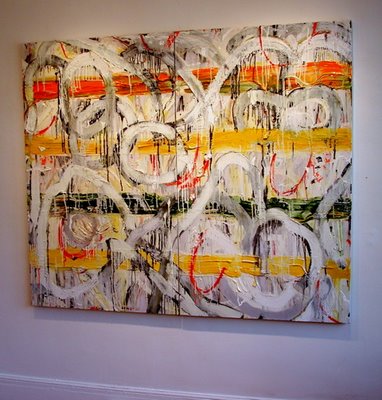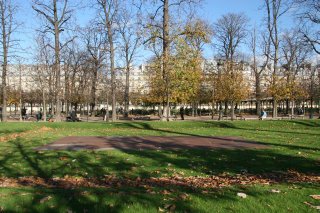
The Ineluctable Redolence Of It All: half dream, half waking world; that moment when if we turn left we see that dream and turn right we see that other, the waking world; when we can shuttle the best of each back and forth, bringing light to both, bringing ENlightenment to both.
Sometimes things are not what they seem. Never have been. I can't speak for the future, but it seems unlikely that this is going to change. Happens over and over again. The way things are is sometimes not the way things are.
But before we kick this around in the context of art, let's hit on some history. Not world history. Just you and me history. For most people it starts with their parents, who aren't telling them everything, or maybe anything, really, not what's going on, not what's what, you know, and then one day we come home from school and daddy isn't there anymore. And of course school is no different: they aren't telling you what's up there either. They're doing one thing and saying another. Sorry to state the obvious, really I am, but it has to be said. It just goes on and on. Workplace. Relationships. These days we get to watch it play out in Washington, live, on cable. And what are we supposed to do with this knowledge? What are we supposed to make of the deception, misdirection, obfuscation? Throw in the towel? Choose some Nietzschean worldview? Good luck!
In the art world the artist and art witness must contend with a double dose of deception. A layer cake of it really. Something Escher would devise, where you didn't know what was what, top or bottom or in-between. I have never had much use for Escher, as they say, nifty art, but for these purposes he is perfect. Anyway, a lot of people seem to like a headgame. I, for better or worse and probably the latter, am not one of them. I grew up with it in my kitchen before I could even think, but knew right off I didn't like it, and promised myself I wouldn't invite it, like some vampire, into my life ever again once I got away. For example, I had such an aversion to the mindgame that whenever I was being intentionally tested by someone, in the classroom, in a standardized test, or with just the riddle, where the idea was to trick me, I froze. A little voice would say: don't mess with me! I would back away. I still do. I've kept my promise too well.
So what of this with art? The coming and going of it. Where to start?
Do we know what art is (ha! or just what we like)? An excellent question! This answer is no. We don't. We think we do. And more importantly, we think we know what isn't(negative!), and that not only includes what isn't art but what isn't good art. But again, we can't know and that is the truth. We don't know what art is just like we don't know what god is, or what love is(there is that old question of whether we love or just think we love, and is there a difference, which is not much different from I think therefore I am), or even, ultimately, what death is. We don't know. There is only what we believe, what we think we know, that we have to know, that we want to know, that it is a matter of ego, pride, zeal, and that's where the trouble starts.
So right away we're in a mess. All down hill from here. Someone makes something that raises the question of whether it is art and then whether it is good art. Are these good questions? Well, maybe, just maybe, they are not even to the point if we can reach some kind of agreement about what might be the thing we are trying to identify/qualify--that is, art.
More paradox? Absolutely!
Have I got anything to add? Beyond beware? Beyond beware that things are never what they seem?
I'm perfectly willing to concede that if not for my aversion to the proverbial mind-game I would not be in this fix in the first place. I would have accepted all of this a long time ago. I would have recognized that the truth, instead of being this thing somewhere in between, is actually an ideal, and therefore an extreme, an unattainable absolute presumably opposed by the equally unattainable absolute of pure lie. And because there is no pure truth, OUR truth IS, like everything else, somewhere in the middle! Somewhere in the sea of grey that is our lives.
For this incredible lack of awareness on my part I apologize. I was one of those really stupid and annoying and often destructive people running around forcing the issue(Life is a parade, so the emperor isn't wearing any clothes, shut up about it kid!). Everything shocked me. Shocked no more. The answer is not Nietzsche, of course, who was clearly a very disturbed individual(so how could his conclusions have been anything but). The answer is more along the lines of eyes wide open, the razor's edge, the straight and narrow, etc. The answer is that sometimes things are what they seem and sometimes they are not. In fact the only truth we may ever know is at best somewhere in between. At best can be a very good thing. And thus I revise my opening statement. We just have to pay attention, which is of course no small statement. It is everything.
Night and day. Truth and lies. Yes and No. Good and bad. Yin and Yang. Half and half. Life is a half a glass of water. That's it! Whether it is half full or half empty is entirely up to us. I have seen deaf kids with a yes so palpable it was blinding, and people who seemingly had it all that couldn't get out of bed in the morning.
I'm often amused by expressions like "fools rush in where angels fear to tread." We can keep peeling them like an onion. The idea of the razor's edge pretty much suggests that that temptation is everywhere, on all sides, but that by walking that paper thin line, which can't help but be cutting, we can do this thing that is not always what it seems. The temptations are huge of course. The power and the glory of art is huge. Immortality. Importance. The temptation to inflate, to compare, to judge, to aggrandize, to compete; to take this wonderful gift and exploit it for power and glory and primacy and superiority and exclusivity over others, over our brothers and sisters in this world; to take this wonderful gift with the power to heal and enlighten and share pleasure and joy and knowledge and feeling and hope and good, and then corrupt it for the purpose of achieving what I believe in Australia they call the plight of the tall poppy. The temptation is huge, but these things are worth nothing. Nothing. Certainly not our first and greatest gift, our life, our self, our soul. They are illusions, sand castles on the water's edge, gone in an instant. In the end all we have is our tall glass of water, and what we do with it makes all the difference.
Of course we are all fools. Fools rushing in. Fools for love. Fools for friends. Fools for family. Fools for politics. Fools for art...
When it comes to art, we are in the extreme. Most people don't even go there. Some people may have it on their walls somewhere, by mistake, but for the most part it is ultimately a painfully acquired taste. We like something we call a work of art that we have experienced. It says it feels what we feel. How we feel. It sees what we see. How we see. It thinks what we think. How we think. There is the first trap. Narcissism. Need. Want. We WANT to connect, and more, to be connected to. We make associations to keep us from being alone. We gather them around us like teddy bears to make us feel safe. And then we begin.
We relate and we are not alone. Art takes us some place. It reassures us. If we make it, then we search for answers, the grail, paradise, perfection, or peace. Which of these can it possibly bring us? Illusions. Illusions that comfort us. Illusions which put us to sleep, like blinders. Or is art just a mark left by where someone has been, like the yellow snow my dog leaves around the yard in winter. That is where it takes us. The mark. Is that all? Is that enough? Why wouldn't it be enough? Van Gogh was here. Frida Kahlo was here. Kiki Smith was here. And then we can tell ourselves "I've been there!" or "I like that place" or "I know that place" or "I hate that place" or "I want to go there!" or something like that.
Is that ok? Is that a reasonable truth? It would seem so. Why ask for more? Why make it about anything more, have to be anything more, or about something else? Can we know this much about art? This small truth? Maybe, but I don't think so.There are phenomena/concepts unknown to us by design--phenomena/concepts we invented that need to remain independent of the control of anyone or any group in the name of knowing, power, or anything else--and we just have to keep them that way, and any frustration we might feel is a small price to pay for the power and freedom these phenomena/concepts, like art, give every living, breathing individual on the planet.








